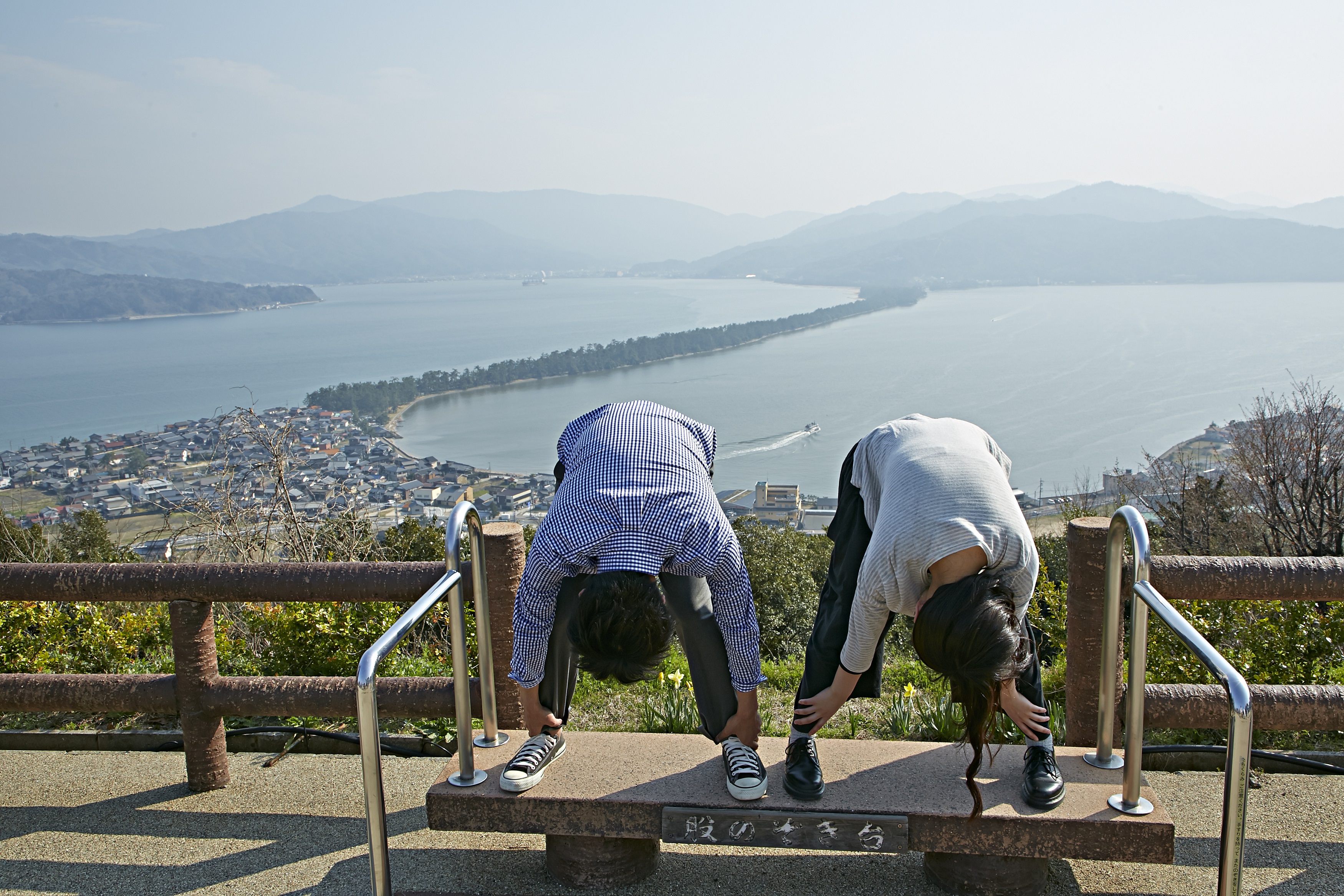
Amanohashidate, one of Japan’s three most famous scenic views, is a naturally-formed geographical feature that is narrow and long, with a total length of about 3.6km.
Legend has it that the god who created Japan used a ladder as a means of traveling back and forth between heaven and earth. And one day, this ladder fell and became Amanohashidate. This spectacular and mystical landscape can be viewed from two observatories.
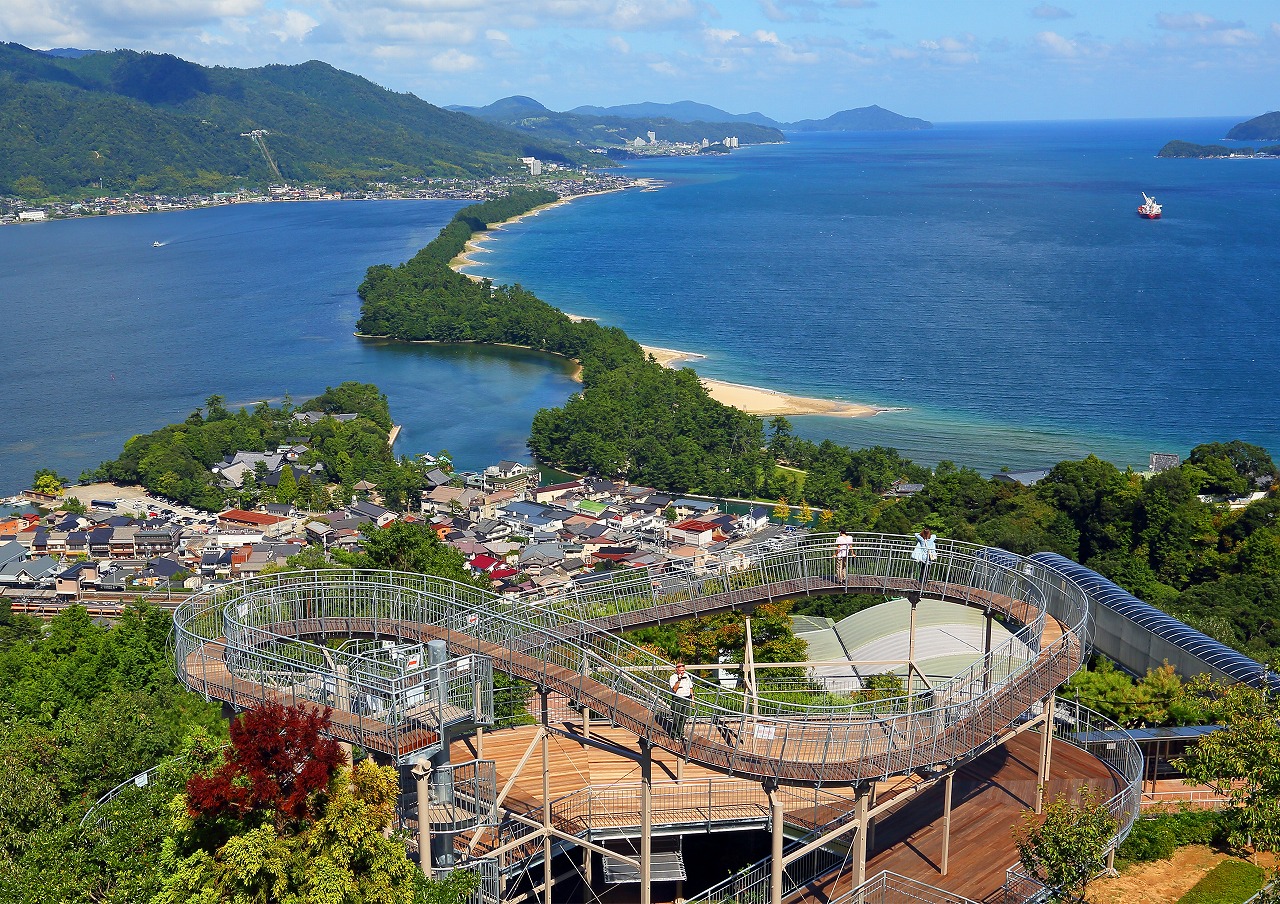
The view of Amanohashidate seen from this Amanohashidate View Land is called “Hiryukan” since it looks like a “flying dragon” up in the heavens. You can experience Amanohashidate’s dynamicism from a top of Mt. Monju. You can take a chair lift or a monorail to the observatory.
Also you can enjoy small amusement park with an observatory, such as cycle-car, merry-go-round, ferris wheel and so on.
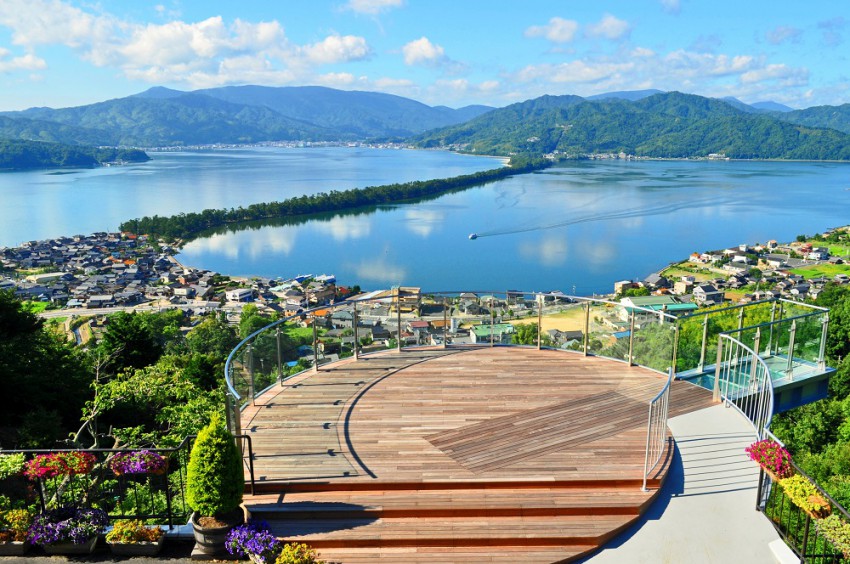
Kasamatsu Park is an observatory that offers a view of Amanohashidate with the blue sea and green pine trees. Stand with your legs apart and bend over to view Amanohashidate from between your legs. This position is called “Matanozoki” in Japanese. Then, the sea and the sky turn upside down, making it looks like a "bridge to the sky".
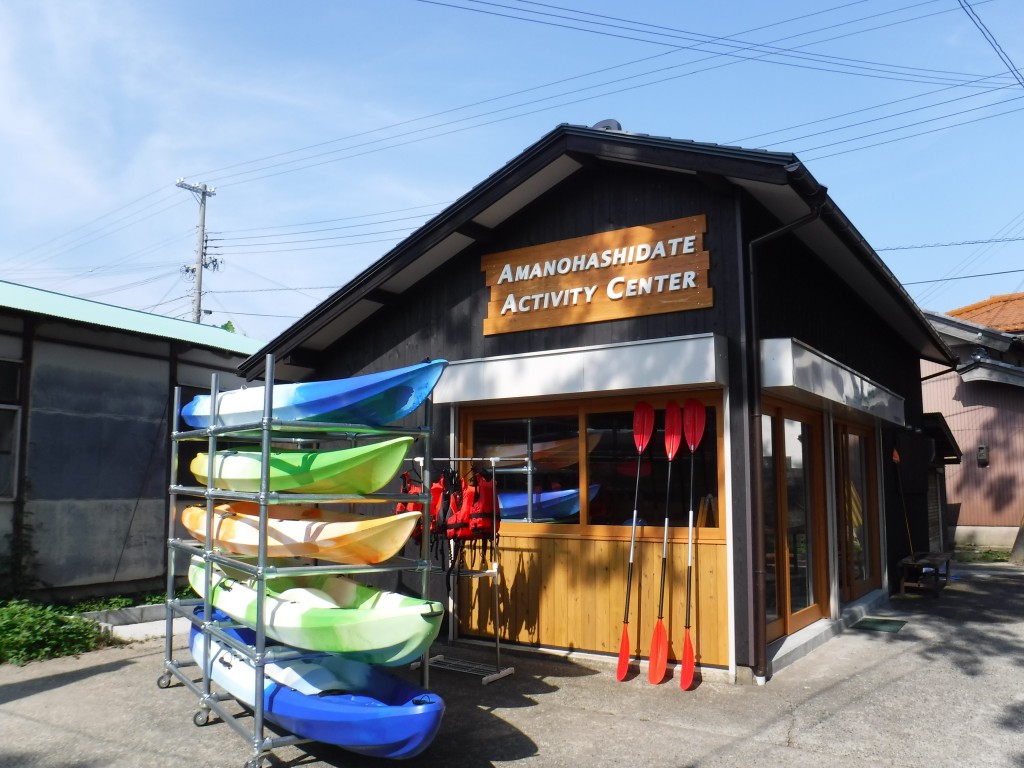
You can experience various Activities at Amanohashidate Activity Center, such as sea kayak, fishing, smoked seafood product making, candle make workshop and so on! For more detail, please ask Amanohashidate tourist information(+81-772-22-8030)
No need to bring anything with you, just have fun at Amanohashidate area and feel the nature.

【Cherry Blossom at Kasamatsu Park】
“Kasamatsu Park”, one of the Amanohashidate two major observatory, is popular place to see cherry blossom in the early April. The view is really picturesque and many tourists take pictures from that observatory in that season.
On both sides of cable car way(or chair lift) bound for Kasamatsu park, there is a lot of cherry blossoms blooming. When riding this, you can feel as if you were passing through the cherry blossom tunnel.
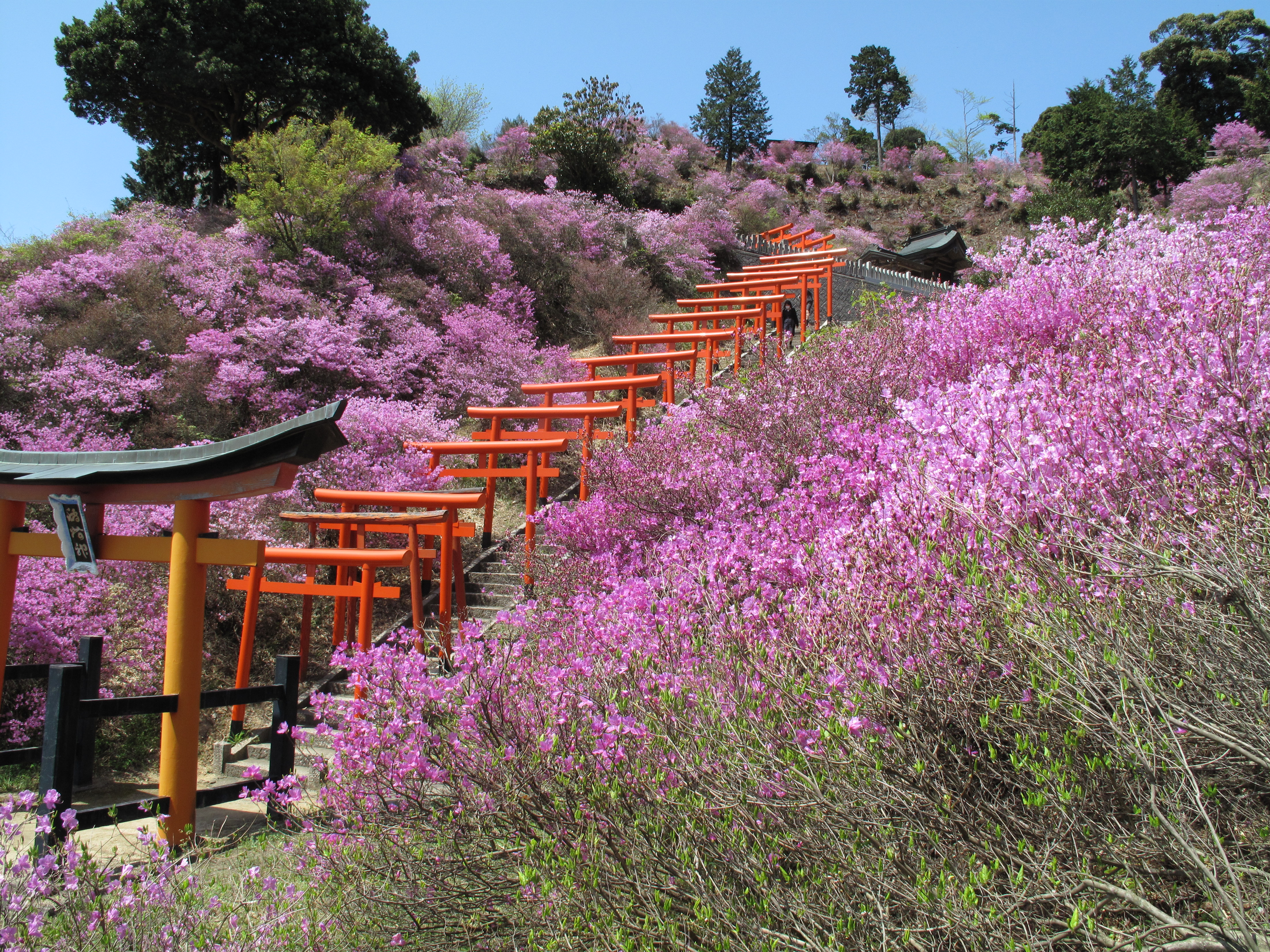
【Mitsuba Tsutsuji at Shiizaki Inari Shrine】
From the middle to the end of April, Mitsuba Tsutsuji at Shiizaki Inari Shrine will full bloom and shows vivid pink flower which surrounds layers of red Torii gate(Shinto gateway). About 1,000 flowers will full bloom in the every April.
The observatory of the mountain top is called “Sesshu-Kan”, because the view from that observatory make us imagine “Amanohashidate-zu” (designated as a national treasure) painted by Sesshu who is famous Japanese ink painter.
■Shiizaki Inari Shrine
https://www.amanohashidate.jp/lang/en/spots/shiizaki-inari-shrine/
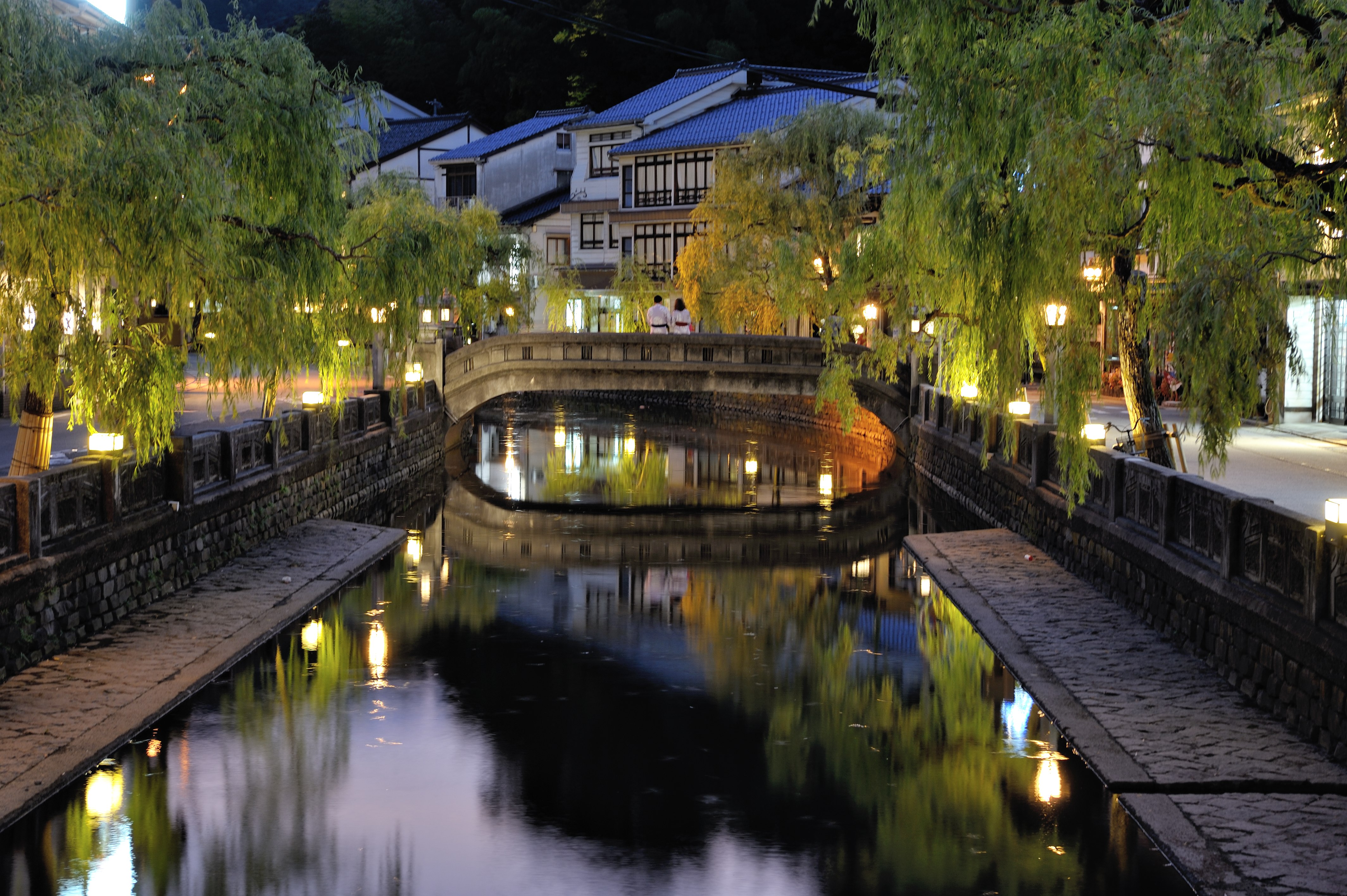
A traditional hot spring town steeped in 1,300 years of history
Kinosaki Onsen, located amongst the quiet mountains of northern Hyogo Prefecture, was founded by the Buddhist monk Dochi Shonin 1,300 years ago when he discovered the area’s mystical hot spring waters. Today, seven distinct bathhouses flow with the healing waters of Kinosaki Onsen, welcoming visitors from near and far to experience the effects for themselves.
Rather than competing against one’s neighbor, the locals of Kinosaki Onsen view their beloved hot spring town as one large ryokan, also known as a traditional Japanese inn.
Guests enter the ryokan doors once they arrive at Kinosaki Onsen Station, stroll through the inn’s hallways as they walk around town, and share the bathhouses with locals while enjoying relaxation unique to Kinosaki. All seven hot spring bathhouses are within walking distance of each other, providing visitors with a cozy, familiar ambiance. Guests don yukata, a light cotton kimono, stroll through the willow-lined streets of the town, and share relaxation with the locals. Guests who spend the night in a ryokan will receive a rental yukata along with a pass to go hot spring hopping in all seven bathhouses.
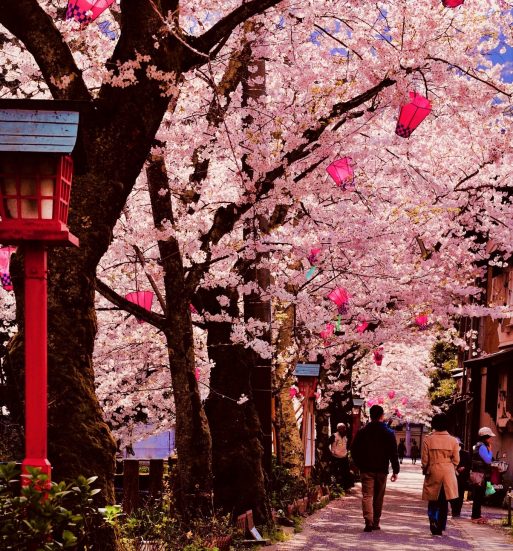
Located just alongside the main road in Kinosaki Onsen, Kiyamachi Street provides a calm, pedestrian-friendly sanctuary perfect for yukata-clad strolls. The cherry blossom season from early to mid-April is a especially spectacular sight on Kiyamachi Street, where the lush greenery following the nearby creek transforms into a spectacle of pink blooms which are lit up with lanterns every evening. Visitors are also welcome to stroll this hidden path to see vibrant fall foliage in autumn, illuminated powder snow branches in winter, and abundant greenery in summer.
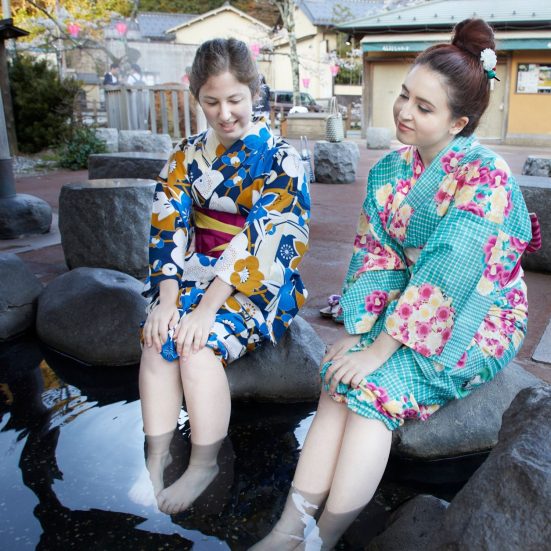
Kinosaki Onsen is home to five free foot baths dotted around town, a perfect momentary respite from exploring the charming hot spring townscape. Visitors can enjoy the simple pleasure of snacking on a Tajima beef bun or some gelato as they rest their weary feet in the therapeutic hot spring waters before their next adventure around town.
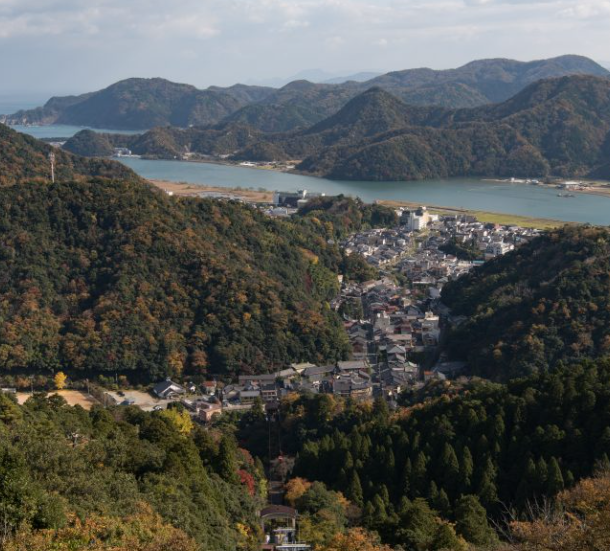
Located in the back of town atop Mount Daishi, the final stop on the Kinosaki Ropeway provides visitors with a panoramic view of Kinosaki Onsen which was awarded a Michelin star. Enjoy a cup of coffee and lunch at the mountaintop cafe while savoring the magnificent sight of Kinosaki Onsen and the Maruyama River.
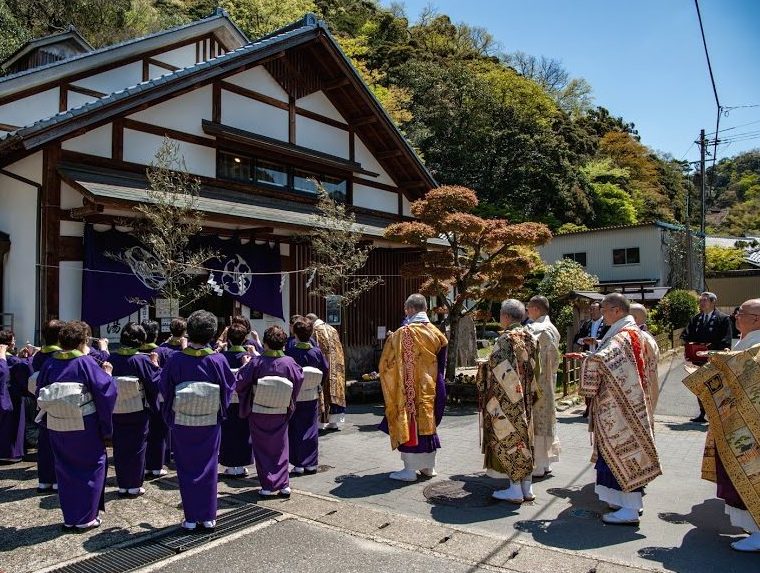
Onsen Festival
Commemorating the work of Dochi Shonin, a Buddhist monk who founded Kinosaki Onsen over 1,300 years ago, the Onsen Festival is one of Kinosaki’s most important yearly events and is held on April 23 and 24 every year, beginning on the date of Dochi Shonin’s death.
In 717 AD during a visit to modern-day Kinosaki Onsen, Dochi Shonin received a vision in telling him to pray for the local people’s health for 1,000 days. On his thousandth day of prayer, it is said that a hot spring shot up from the ground, creating Kinosaki Onsen.
The Buddhist monks from Onsenji, the guardian Buddhist temple of Kinosaki Onsen, bless each of the seven hot springs to wish for the safety, well-being, and prosperity of Kinosaki Onsen and its people.
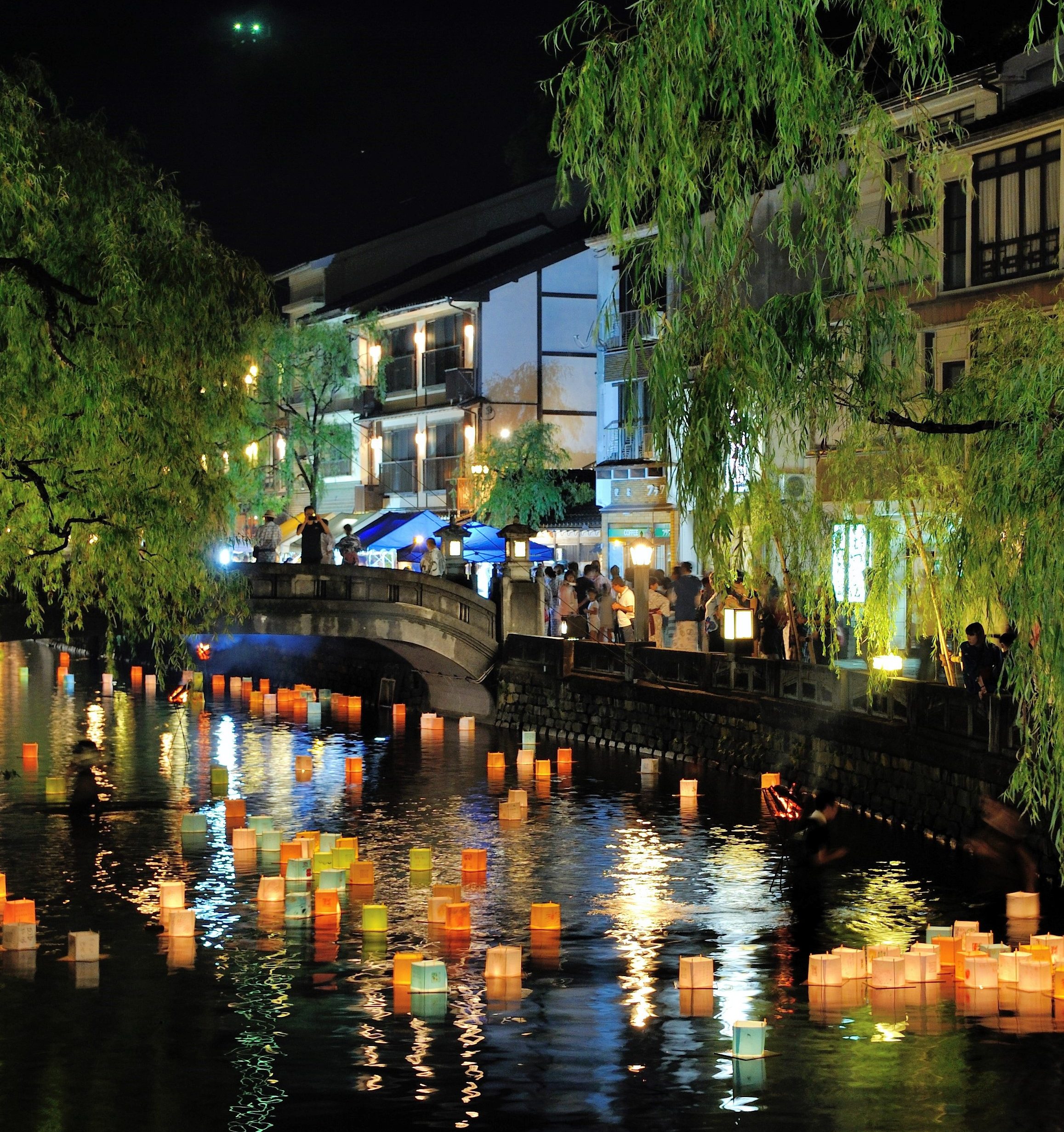
Lantern Festival
On a warm summer night in August, Kinosaki Onsen has made it a tradition to welcome the wishes and dreams of locals and visitors alike to illuminate the Otani River running through the hot spring town.
The citizens of Kinosaki Onsen invite neighborhood locals and hot spring-goers to write wishes on lanterns before releasing them into the Otani River. The wishes of the lantern-bearer are written in colorful inks, sometimes accompanied by drawings and messages to others, and are then gently placed in the river with the help of festival staff.
Those interested in floating a lantern down the river are able to write their wishes and messages at a table before handing their paper to staff members who construct the wooden portion of the lantern. Afterwards, lantern-bearers climb down to a float sitting atop the Otani River, where staff help release the lanterns out onto the water.
As the lanterns are carefully guided one by one down the Otani River, visitors dressed in vibrantly designed yukata, also known as light cotton kimono, gather along the streets and willow-decorated bridges of Kinosaki Onsen to admire the gorgeous rainbow of wishes and dreams gradually illuminating the evening waters.
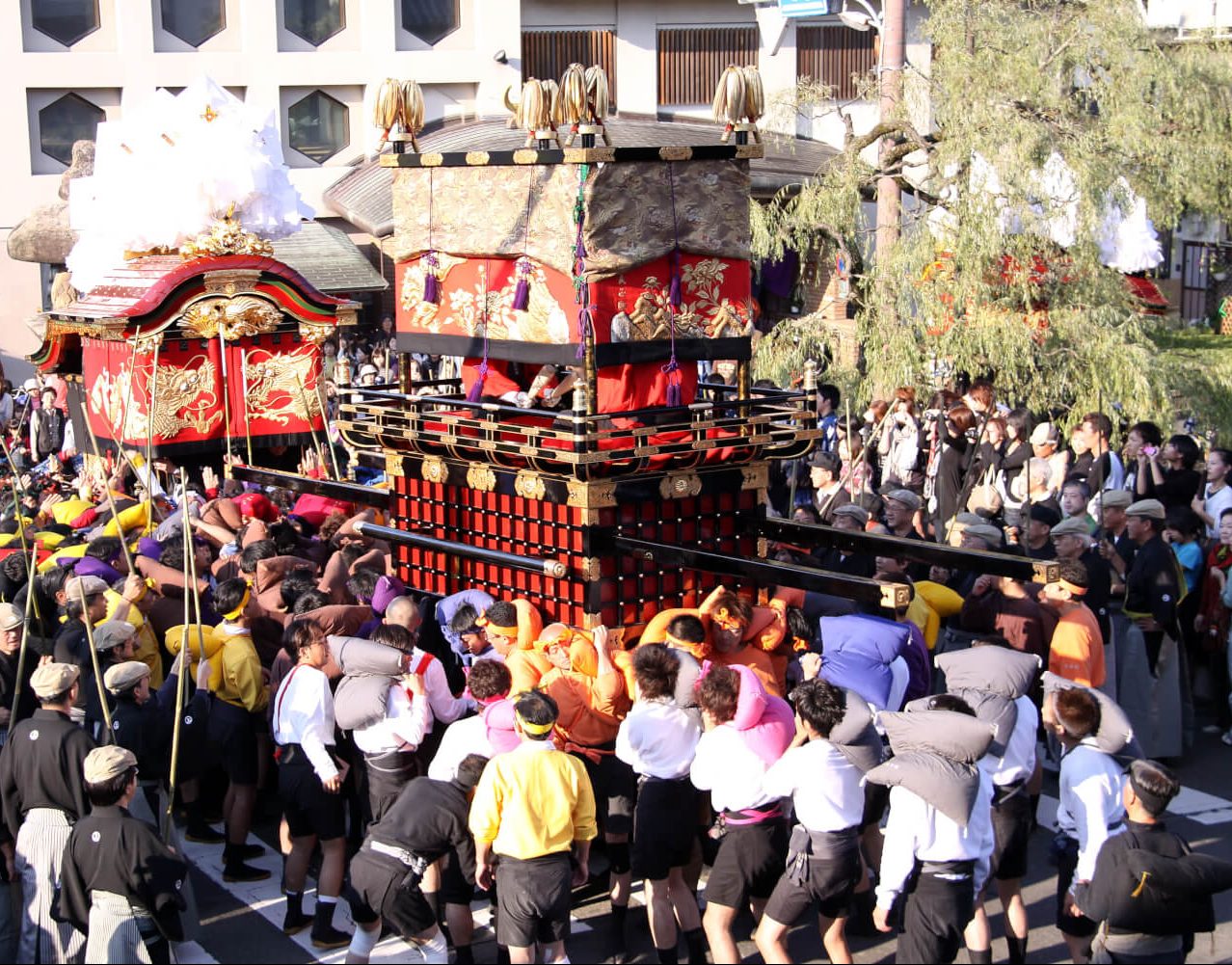
Danjiri Festival
In Japan, Danjiri Festivals are also known as “fighting shrine festivals” in which staged battles between elaborately decorated wooden floats in the shape of a shrine or temple are pulled by locals.
In Kinosaki Onsen, the Danjiri Festival is held on October 14 and 15 to worship the guardian deity of hot springs and the guardian deity of water at Shisho Shrine, as well as to pray for a good harvest and safety. The festival contributes to the story Shisho Shrine’s deity traveling to all of Kinosaki Onsen’s seven mystic hot springs to pray, when on its way home to Shisho Shrine, a large danjiri float blocks their path. The quiet hot spring town will become alive with thundering drums and chants as locals push their 5 carts near the willow-lined bridges of Kinosaki Onsen, a popular attraction with visitors.
| JR | Kyoto Tango Railway | ||||
|---|---|---|---|---|---|
| Kinosaki Onsen Station | Train Name | Toyooka station | Train Name | Amanohashidate station | |
| Dep. | Arr. | Dep. | Arr. | ||
| 9:33 | Ltd. Express Kounotori No.12 | 9:42 | 9:51 | Local train for Nishi-Maizuru | 11:06 |
| 10:39 | Ltd. Express Kinosaki No.12 | 10:48 | 11:00 | Local train for Nishi-Maizuru | 12:11 |
| 11:40 | Local train for Fukuchiyama | 11:54 | 12:00 | Local train for Nishi-Maizuru | 13:14 |
| 12:37 | Local train for Toyooka | 12:54 | 13:00 | Local train for Nishi-Maizuru | 14:18 |
| 14:42 | Local train for Fukuchiyama | 14:56 | 15:04 | Local train for Nishi-Maizuru | 16:17 |
| 15:50 | Rapid service train for Toyooka | 16:00 | 16:16 | Local train for Toyooka | 17:53 |
| Kyoto Tango Railway | JR | ||||
|---|---|---|---|---|---|
| Amanohashidate Station | Train Name | Toyooka Station | Train Name | Kinosaki Onsen Station | |
| Dep. | Arr. | Dep. | Dep. | ||
| 10:16 | Local Train For Toyooka | 11:30 | 11:43 | Ltd. Express Kounotori No.3 | 11:52 |
| 11:33 | Local Train For Toyooka | 12:48 | 13:02 | Local Train For Hamasaka | 13:16 |
| 12:37 | Local Train For Toyooka | 13:49 | 13:55 | Local Train For Kasumi | 14:07 |
| 13:18 | Local Train For Toyooka | 14:41 | 14:45 | Ltd. Express Kounotori No.9 | 14:54 |
| 14:33 | Ltd. Express Hashidate No.5 | 15:34 | 15:41 | Ltd. Express Kinosaki No.7 | 15:50 |
| 15:21 | Local Train For Toyooka | 16:47 | 17:00 | Local Train For Hamasaka | 17:12 |
For more information of Amanohashidate
http://www.amanohashidate.jp/lang/en/
For more information of Kinosaki Onsen
https://visitkinosaki.com/th